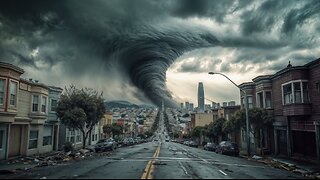Premium Only Content

USA NOW! Deadly Midwest Storm: Tornadoes, Hurricane Winds, and 500 Miles of Destruction
Historical Severe Weather Strikes the U.S. Midwest on the Evening of July 15, 2024.
Storms with wind gusts reaching Category 2 hurricane levels toppled trees, tore roofs off buildings, and downed power lines, leaving a nearly 500-mile path of destruction from Iowa to Indiana. Nearly 500,000 people were left without power. At least one person was killed in Indiana when a tree fell on a house.
Meteorologists estimate that this storm system meets the criteria for a derecho. A derecho is characterized by destructive winds caused by clusters of severe thunderstorms that can knock down trees and damage buildings, as well as generate tornadoes along the leading edge.
More than 30 tornado warnings were issued across the Midwest. In Iowa, two of the state's three largest cities were impacted by tornadoes. An EF-1 tornado was recorded in Davenport, with wind speeds of 100 miles per hour, traveling 8 miles on the ground. Another EF-1 tornado struck Des Moines, with wind speeds of 100-105 miles per hour, spanning more than 7 miles. Notably, this was the second tornado to hit the city this year.
In Iowa, several towns also suffered from strong straight-line winds. In Aurora, wind gusts reached 86 miles per hour. In Robins, winds caused significant damage to trees and power lines.
The storm also hit Illinois.
In Joliet, winds up to 70 miles per hour tore part of the roof off the Illinois Rock & Roll Museum and The Forge club. In Camp Grove, a wind gust of 105 miles per hour was recorded. Tornado sirens wailed for the second consecutive night in the Chicago metro area on Monday. The previous day, tornadoes had also struck the city. Tornadoes are relatively rare in Chicago. According to meteorologist Paul Dinnodo, only six tornadoes had been recorded in the city over the past 70 years until this event.
Monday evening was dreadful for travelers at Chicago's O'Hare and Midway airports. Airport webcams captured signs of possible tornadoes or destructive wind gusts. The storm caused significant damage near O'Hare International Airport, including uprooted trees and broken structures. Some passengers had to wait out the storm in planes on the runway.
Local trains were also canceled.
Part of Interstate 55 on the outskirts of Chicago remained closed on Tuesday morning after strong winds overturned several semi-trailers and downed high-voltage power lines onto cars.
As of Tuesday evening, the National Weather Service in Chicago confirmed at least 12 tornadoes in northern Illinois, including an EF-1 on the western side of Chicago.
The storm triggered significant flooding. Residents of Rockford were shocked by the scale of the flooding, noting that storms had never brought such floods before.
It should be emphasized that within just three days, the Midwest and Northern Plains regions were hit by two derechos in a row. The previous storm struck the region on Saturday, June 13. This clearly shows the rapid increase in dangerous climate events in the U.S.
Another important fact to note is that the derecho left half a million consumers without power. Meanwhile, in Texas, eight days after the hit of Tropical Storm Beryl, nearly 150,000 people were still without power. This was happening amid dangerous health-threatening high temperatures in the region.
It is evident that we are vulnerable to growing natural disasters. One of the most serious vulnerabilities is our energy infrastructure. The elements destroy it, and recovery often takes days or even weeks. It is now crucial for humanity to find and start using alternative energy sources that are impervious to hurricanes, tornadoes, extreme heat, and other severe weather events. Otherwise, we will not survive.
Such technologies already exist. They can provide people with the necessary energy anywhere on the planet, help us survive the impending climate collapse, and take humanity to a new, higher level of development. But we cannot use them yet. Do you want to know why? And most importantly, how to make these technologies accessible to every person on the planet? The answers can be found in the documentary "Water From Air: The Path to Saving Humanity | Popular Science Film."
What will we choose: chaos, destruction, and ultimately extinction, or the implementation of new technologies and a rapid leap in the development of our civilization?
-
 5:49
5:49
AllatRa TV
5 days agoUSA NOW! Atmospheric River Fuels Chaos in California: Tornado, Floods, and Snowfall
1361 -
 11:45:14
11:45:14
Right Side Broadcasting Network
9 days agoLIVE REPLAY: TPUSA's America Fest Conference: Day Three - 12/21/24
306K28 -
 12:19
12:19
Tundra Tactical
12 hours ago $11.79 earnedDaniel Penny Beats Charges in NYC Subway Killing
49.1K10 -
 29:53
29:53
MYLUNCHBREAK CHANNEL PAGE
1 day agoUnder The Necropolis - Pt 1
141K45 -
 2:00:10
2:00:10
Bare Knuckle Fighting Championship
3 days agoCountdown to BKFC on DAZN HOLLYWOOD & FREE LIVE FIGHTS!
49.5K3 -
 2:53:01
2:53:01
Jewels Jones Live ®
1 day agoA MAGA-NIFICENT YEAR | A Political Rendezvous - Ep. 103
138K33 -
 29:54
29:54
Michael Franzese
15 hours agoCan Trump accomplish everything he promised? Piers Morgan Article Breakdown
122K54 -
 2:08:19
2:08:19
Tactical Advisor
19 hours agoThe Vault Room Podcast 006 | Farwell 2024 New Plans for 2025
194K11 -
 34:12
34:12
inspirePlay
1 day ago $5.84 earned🏆 The Grid Championship 2024 – Cass Meyer vs. Kelly Rudney | Epic Battle for Long Drive Glory!
89.9K8 -
 17:50
17:50
BlackDiamondGunsandGear
17 hours ago $3.17 earnedTeach Me How to Build an AR-15
63.9K6